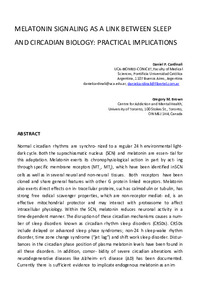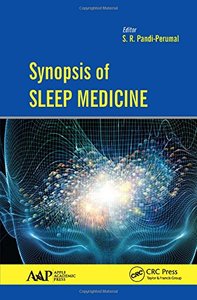Please use this identifier to cite or link to this item:
https://repositorio.uca.edu.ar/handle/123456789/10185| Título: | Melatonin signaling as a link between sleep and circadian biology : practical implications | Autor: | Cardinali, Daniel Pedro Brown, Gregory M. |
Palabras clave: | MELATONINA; SUEÑO; RITMO CIRCADIANO; TRASTORNOS DEL SUEÑO; BENZODIAZEPINAS; ENFERMEDAD DE ALZHEIMER | Fecha de publicación: | 2016 | Editorial: | Apple Academic Press | Cita: | Cardinali, D. P., Brown, G. M. Melatonin signaling as a link between sleep and circadian biology : practical implications [en línea]. En: Pandi-Perumal, S. R. (ed.). Synopsis of sleep medicine. Toronto ; New Jersey : Apple Academic Press, 2016 Disponible en: https://repositorio.uca.edu.ar/handle/123456789/10185 | Resumen: | Abstract: Normal circadian rhythms are synchronized to a regular 24 h environmental light-dark cycle. Both the suprachiasmatic nucleus (SCN) and melatonin are essential for this adaptation. Melatonin exerts its chronophysiological action in part by acting through specific membrane receptors (MT1, MT2), which have been identified in SCN cells as well as in several neural and non-neural tissues. Both receptors have been cloned and share general features with other G protein linked receptors. Melatonin also exerts direct effects on intracellular proteins, such as calmodulin or tubulin, has strong free radical scavenger properties, which are non-receptor mediated, is an effective mitochondrial protector and may interact with proteasome to affect intracellular physiology. Within the SCN, melatonin reduces neuronal activity in a time-dependent manner. The disruption of these circadian mechanisms causes a number of sleep disorders known as circadian rhythm sleep disorders (CRSDs). CRSDs include delayed or advanced sleep phase syndromes; non-24 h sleep-wake rhythm disorder, time zone change syndrome (“jet lag”) and shift work sleep disorder. Disturbances in the circadian phase position of plasma melatonin levels have been found in all these disorders. In addition, comorbidity of severe circadian alterations with neurodegenerative diseases like Alzheimer’s disease (AD) has been documented. Currently there is sufficient evidence to implicate endogenous melatonin as an important mediator in CRSD pathophysiology. The documented efficacy of melatonin to reduce chronic benzodiazepine/Z drug use in insomnia patients is also discussed. | URI: | https://repositorio.uca.edu.ar/handle/123456789/10185 | ISBN: | 978-1-77188-346-7 (impreso) 978-1-77188-347-4 (online) |
Disciplina: | MEDICINA | Derechos: | Acceso abierto | Fuente: | Pandi-Perumal, S. R. (ed.). Synopsis of sleep medicine. Toronto ; New Jersey : Apple Academic Press, 2016 |
| Appears in Collections: | Libros o partes de libro |
Files in This Item:
| File | Description | Size | Format | |
|---|---|---|---|---|
| melatonin-signaling-link-between.pdf | 1,26 MB | Adobe PDF |  View/Open | |
| cover.jpg | 51,51 kB | JPEG |  View/Open |
Page view(s)
121
checked on Apr 30, 2024
Download(s)
230
checked on Apr 30, 2024
Google ScholarTM
Check
Altmetric
This item is licensed under a Creative Commons License

